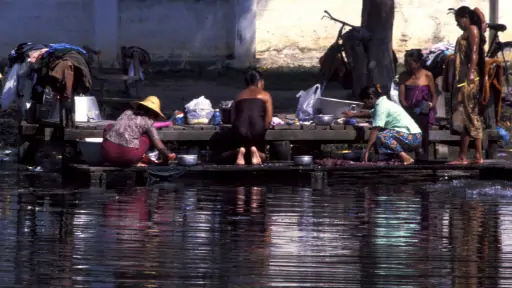Indigenous Calendar April, 2018: Before the Storm

When, a year ago, the Whanganui River in New Zealand and the Ganges and Yamuna Rivers in India became the first rivers ever to be granted legal status, I predicted that it would represent "the calm before the storm." My prediction would have been no surprise to the indigenous people for whom these rivers are important. We find water in abundance in indigenous folklore. Commonly, such folklore tells of mythical creatures that live in water. For example, in parts of Africa, jengu and mami wata are spirits that mediate between the human and supernatural worlds. In some Celtic cultures, roanes (selkies) are seals that become human when they shed their skin and leave the water. The wonderful 1995 film The Secret of Roan Inish tells their story. In indigenous Australia, bunyip are creatures that eat humans. In North America, the Lakota people believe in the water snake, uncegila. Many bodies of water are so polluted today that even these mythical creatures of antiquity would no longer want to live in them.
Probably the reason why water is such a large part of indigenous storytelling tradition is that almost all human settlements were originally established close to some water source. They had to be since life cannot survive without it. After a legacy of thousands of years of indigenous knowledge, the rest of us finally seem to be awakening to what we can learn. A few days ago we celebrated World Water Day with the theme 'Nature for Water.' At a time when almost a quarter of the world's population does not have clean drinking water, this year's theme proclaimed that the solution lies in nature itself. Once again, this would have been no surprise to indigenous people.
Water is important to indigenous people not just for life but also for the spirituality and the sense of community it represents. In eastern Burma (Myanmar) I was in a small Shan village. The river running through it is the center of village activity. It serves as a place to bathe (the village has no running water), a place to wash clothes and household utensils, a meeting place to share news and gossip and a site for rituals.
In Cape Town, South Africa, they are close to running out of water after a three-year drought. Indeed, until recently the city had been scheduled to turn off its running water this month. Only severe rationing was able to avoid doing so. And Cape Town is just a drop in the ocean. Cities worldwide are facing, or soon will face, similar crises.
Whether it's the death of Sudan, the world's last male northern white rhino, in Kenya a few days ago or the realization, last year, that Australia's Great Barrier Reef can no longer be protected, we are beginning to see the impacts of our lifestyle choices. Of all the events that took place on World Water Day one stands out. Aged just 13, Autumn Peltier addressed the United Nations General Assembly. Of course, she is an indigenous person — Anishinaabe from Ontario, Canada, where, last month, she became an Ontario Junior Citizen of the Year. At the launch of the United Nations International Decade for Action on Water for Sustainable Development she advocated that all water be given human rights. Perhaps if we listen to water protectors like Peltier, the storm has begun.
The Shan are featured in our documentary, Indigenous Peoples of Southeast Asia.
If you enjoyed reading this article, please consider supporting independent, advertising-free journalism by buying us a coffee to help us cover the cost of hosting our web site. Please click on the link or scan the QR code. Thanks!


